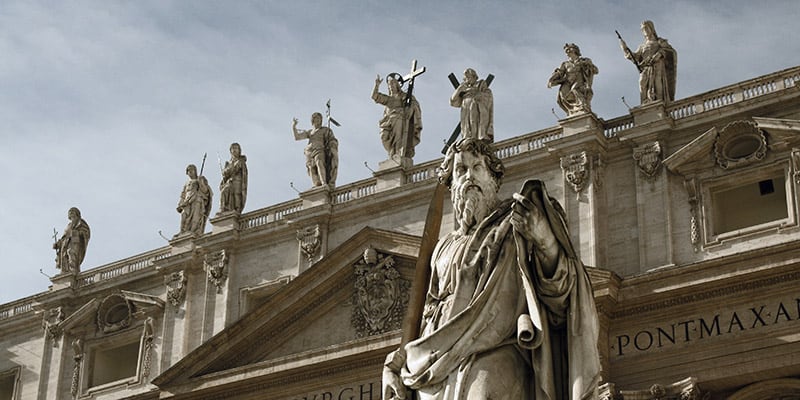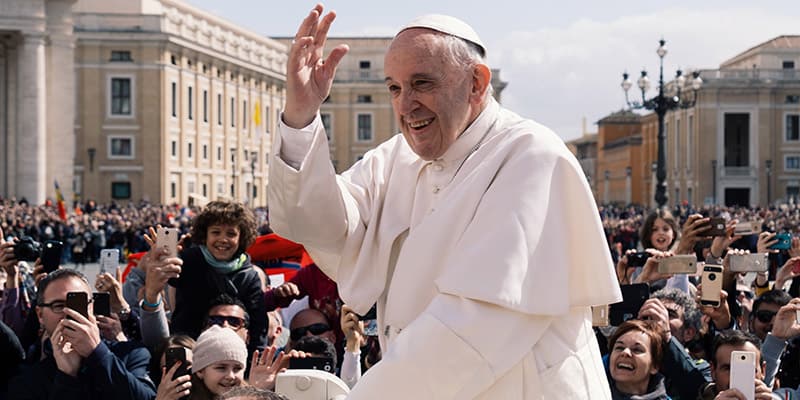10 Things You Need to Know Before You Go: St Peter’s Basilica in Rome

Michelangelo’s Dome as seen from Castel Sant’Angelo, image by Wolfgang Stuck sourced from Wikimedia Commons
St. Peter’s Basilica is without a doubt Rome’s main attraction besides the Colosseum, totaling a staggering 40,000 visitors per day, which include actual churchgoers along with pilgrims and regular tourists.
In spite of the amount of people passing through its doors daily, many travelers don’t know the details about the largest church in the world, and they just go there to tick the proverbial box.
St. Peter’s Basilica is a world unto itself, and so in an attempt of intriguing those readers who are looking to visit Vatican City, I put together a collection of trivia and facts you might not know: here’s what you need to know about this monumental shrine.
1. It didn’t always look this way

Detail of the statues from the façade of St Peter’s Basilica, image by Nils Huber sourced from Unsplash
The current appearance of St. Peter’s Basilica is the result of its most recent renovation (or shall I say “reconstruction”?): building began under Pope Julius II in 1506 and was completed under Paul V, roughly a century later, in 1615.
As a matter of fact, the complete name of the church is “New St. Peter’s Basilica“, so as to differentiate it from the one that came before it. Indeed, in exactly the same location, Emperor Constantine had built in the 4th century what is now known as “Old St. Peter’s Basilica”. That, in turn, had been built over a small chapel for what was believed to be the tomb of St. Peter’s.
Old St. Peter’s Basilica was torn down to make space for the new one. If you need to know what it looked like, visit Santa Maria in Trastevere or the church of Santa Maria in Cosmedin (where the famous Mouth of Truth is, by the Circus Maximus) and you can get a general idea!
Old St. Peter’s Basilica had been built partly above the Circus of Nero (similar to the Circus Maximus) and partly over a cemetery – while we lost the former (the building was dismantled to create the first church), you can still visit the latter: read about it here. The only visibile trace that the Circus was ever there is the obelisk now standing in the middle of St. Peter’s Square.
2. Entrance to the church is free

St. Peter’s Basilica at a glance from Via della Conciliazione, image by Sean Ang sourced from Unsplash
Should people accost you outside the Basilica asking you for money to enter, don’t fall for it: you only pay a fee if you wish to climb to the top of the dome.
Of course you’re welcome to buy a guided tour or to join a group visit, in which case it’s perfectly normal to pay for the services you receive. However, climbing the dome to the church or paying a guide are extras, while basic access to St. Peter’s Basilica is always, and always will be, free. As is with all other churches in Rome!
3. Security first!

The queue for entering St. Peter’s Basilica on an average summer day, image by Jordiferrer sourced from Wikimedia Commons
In 1972, a Hungary–born Australian man by the name of László Tóth attacked Michelangelo’s Pietà with a hammer and all but destroyed Mary’s left arm and nose. The marble masterpiece had to be painstakingly restored… and security measures had to be greatly implemented.
Currently, you have to pass through a metal detector before you can go into St. Peter’s Basilica. You won’t be able to enter with tripods, bags or backpacks larger than 40x35x15 centimetres, umbrellas, anything that is pointy, made of metal or has a blade. The whole list of prohibited items is here and it also includes… hats.
4. Dress appropriately!

Can you tell from this picture who’s going to get turned away at St. Peter’s Basilica? image by Jorge Royan sourced from Wikimedia Commons
Speaking of security, guards are particularly strict on the subject of decorum. Even if you’re not religious, you will need to dress modestly for the occasion, which means no sleeveless tops, short skirts or overly short… shorts.
More generally speaking, your shoulders, knees and midriff should be covered before you can enter St. Peter’s Basilica. You can use a cardigan, a cotton scarf or even zip off pants for your visit, then resume to dress… less conservatively.
This rule is also in effect at most other churches, in Rome as well as the rest of Italy: even if you’re only interested in the masterpieces there, you should remember that these are places of worship before anything else.
5. Want to see the Pope? Here is how

Pope Francis surrounded by the crowds on St. Peter’s Square, image by Ashwin Vaswani sourced from Unsplash
If your holiday coincides with a Wednesday and the Pope is in Rome on that day, you may want to attend a so–called “Papal audience“, where the pontiff will show up to pray along with the faithful and talk about some teachings from the Bible. This is shorter than a Holy Mass.
The Audience begins at 10AM, but people will show up hours before it just to get a good seat, as it’s a “first come, first serve” kind of event. To participate in a Papal audience, you will need to book tickets. To do so, what you also will need to do is filling a form, found at this address and choose a date (it’s better to do so in advance!).
Papal audiences will take place into St. Peter’s Basilica in the colder months, and on St. Peter’s Square during the summer.
Keep in mind that booking a ticket is mandatory but is free: it’s just a security measure to screen participants ahead of time.
Alternatively, the Pope will show up at his window on Sundays, again if he is in Rome at the time, for the Angelus address, which happens at noon. Right before it and after it, St. Peter’s Basilica will be closed, so if you mean to also visit that you will need to wait!
The Angelus address is also a free event: you just stick around St. Peter’s Square until the Pope appears – you don’t have to pay nor you need to book any ticket.
6. Headed for the dome? Read this first!
Climbing the dome at St. Peter’s Basilica is the surefire way to get the greatest view of all of Rome, but it comes at a price (well, two prices, actually!).
You can either pay 6 EUR to walk the whole 551 steps to the terrace on the roof, or you can pay 8 EUR and be allowed to use an elevator – which will only spare you 231 steps, though.
Not only the climb is not recommended to those having a walking disability, it’s also unadvisable to those suffering from claustrophobia because the stairs are at times incredibly narrow. And for a reason: they were not intended as the route to a tourist attraction, but the way for laborers to build the dome.
Yes, it’s an uncomfortable experience (at least part of it), but a very humbling one when you think of who climbed the stairs first.
7. The view from the dome also used to be very different!
St. Peter’s Basilica is not the only thing that underwent a, well, makeover, in the area. Compare the photo above with the one below, and then answer the question: ever been to Orvieto?

The view from the dome at St. Peter’s before the demolitions of 1936 occurred, image in the public domain sourced from Wikimedia Commons
Even if you haven’t, know this: you have to walk down some narrow, winding alleys before the cathedral there appears almost out of the blue. The effect was exactly the same in Rome… at least until 1929.
When Mussolini signed the Lateran Treaties with Pope Pius XI that year, it was decided that the borough at the foot of the church, called Spina di Borgo, should have been torn down to make way for a monumental road that would connect the symbol of christianity (St. Peter’s) with the rest of Rome. The street would have made the Basilica more easily approachable by car, and would also signify the peace between the church and the fascist government.
The name of the road? Via della Conciliazione: “Reconciliation Road”. That’s the huge avenue you walk down today, in all likelihood, in order to reach the Basilica. Ironically, older Romans don’t feel exactly reconciled with that decision, since many of them were displaced, their houses destroyed, to make way for the new street.
Demolitions began in 1936, and tore down, regardless of their artistic importance, monuments, palazzos, churches… The only areas left untouched close to the Vatican itself are now Borgo Pio, Borgo Vittorio and, to a lesser extent, Borgo Angelico: walk down there and imagine what medieval Rome in this area used to look like!
8. Art inside the Basilica
Many different artists worked for the Popes and, obviously, participated in the building of the new Basilica.
Donato Bramante, Michelangelo, Carlo Maderno and Gian Lorenzo Bernini, among others, designed the building, while more plans for it and work was done by the likes of Giuliano da Sangallo, Raphael, Giorgio Vasari or Giacomo della Porta. Art inside St. Peter’s has been created by Bernini along with Michelangelo, Pietro da Cortona, Francesco Borromini, Arnolfo di Cambio, Antonio Canova, Cavalier d’Arpino and so many more.
The sheer amount of artists who participated in the creation of the Basilica as we know it today is one of the reasons why it is such a heavily-visited tourist destination.
9. Scandals at St. Peter’s
With such a complex process behind its establishment, it was inevitable that the Basilica would attract gossiping, envy and hearsay.
For instance, Michelangelo was compelled to sign his Pietà because word went around that the amazing statue was not his but his colleague Cristoforo Solari. Later Michelangelo was so ashamed by his ego taking over that he decided never to sign anything he did ever again.
Gian Lorenzo Bernini was at one point responsible for designing the façade of St. Peter’s Basilica: his project involved completing two massive bell towers. Obviously you will have noticed that they are no longer there! That’s because when the first one had almost been completed, cracks began to appear in it, which urged the Pope at the time, Innocent X, to order a hasty demolition. Bernini was later exonerated from any responsibility, but for a few years he fell into disgrace.
Also of note is the role of the noble Barberini family in the building of one of the most admired works of art in the Basilica.
Pope Urban VIII famously stripped the Pantheon’s bronze roof tiles so that Bernini himself could have enough metal for the magnificent canopy now housed inside. This was when one of the most well-known latin mottoes in Rome originated: “Quod non fecerunt barbari, fecerunt Barberini“, it recites, which means “What the barbarians didn’t do, the Barberinis did“.
Terrible memories of the Sack of Rome were still fresh in the minds of Romans, and this sentence summed up very well the outrage for the pillaging of the much loved templed-turned-church at the hands of a local family.
10. Want to look at the Basilica? Step away from it!

St. Peter’s Basilica as seen from the Knights of Malta keyhole on the Aventine Hill, image by Galen Crout sourced from Unsplash
Photography lovers, if you’re looking for the best place to take pictures of St. Peter’s Basilica, you will have to move out of the square. I can give you three options, all of them with a vantage point on the dome.
Look for a Via Piccolomini, north of the site, by Via Gregorio VII: an optical illusion makes it so that this quiet residential street seems really close to the Vatican dome. As a matter of fact, the closer you walk from there to St. Peter’s, the more it looks like the dome is shrinking. A must-see!
Via Monte del Gallo is quiet, winding alley by the train station at Roma San Pietro. If you walk uphill to the top of the street, you can have unobstructed views over the church.
Finally, you can commute by bus (lines no. 23 or 280 will take you close enough!) to the Aventine Hill and look for the Priory of the Knights of Malta there. A religious order of crusaders from the 11th century, you don’t even have to go in there to enjoy one of the greatest views over the Basilica: just peek through its gates’ keyhole and know this is one of the greatest photo opportunities you can have while in Rome!
Planning a trip to Paris ? Get ready !
These are Amazon’s best-selling travel products that you may need for coming to Paris.
Bookstore
- The best travel book : Rick Steves – Paris 2023 – Learn more here
- Fodor’s Paris 2024 – Learn more here
Travel Gear
- Venture Pal Lightweight Backpack – Learn more here
- Samsonite Winfield 2 28″ Luggage – Learn more here
- Swig Savvy’s Stainless Steel Insulated Water Bottle – Learn more here
Check Amazon’s best-seller list for the most popular travel accessories. We sometimes read this list just to find out what new travel products people are buying.













